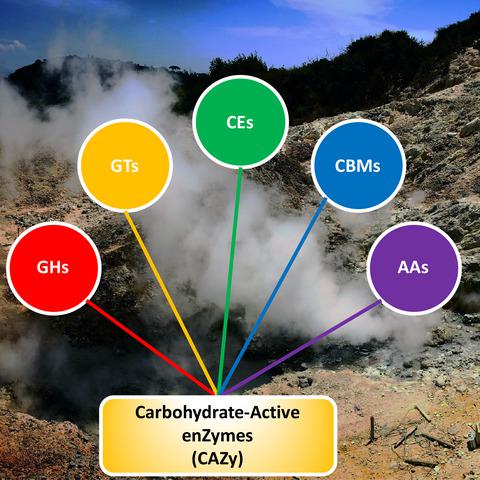Our official English website, www.x-mol.net, welcomes your
feedback! (Note: you will need to create a separate account there.)
Discovery of hyperstable carbohydrate-active enzymes through metagenomics of extreme environments.
The FEBS Journal ( IF 5.5 ) Pub Date : 2019-10-08 , DOI: 10.1111/febs.15080 Andrea Strazzulli 1, 2 , Beatrice Cobucci-Ponzano 3 , Roberta Iacono 1, 3 , Rosa Giglio 3 , Luisa Maurelli 3 , Nicola Curci 1, 3 , Corinna Schiano-di-Cola 3 , Annalisa Santangelo 1 , Patrizia Contursi 1, 2 , Vincent Lombard 4 , Bernard Henrissat 4, 5 , Federico M Lauro 6, 7 , Carlos M G A Fontes 8, 9 , Marco Moracci 1, 2, 3
The FEBS Journal ( IF 5.5 ) Pub Date : 2019-10-08 , DOI: 10.1111/febs.15080 Andrea Strazzulli 1, 2 , Beatrice Cobucci-Ponzano 3 , Roberta Iacono 1, 3 , Rosa Giglio 3 , Luisa Maurelli 3 , Nicola Curci 1, 3 , Corinna Schiano-di-Cola 3 , Annalisa Santangelo 1 , Patrizia Contursi 1, 2 , Vincent Lombard 4 , Bernard Henrissat 4, 5 , Federico M Lauro 6, 7 , Carlos M G A Fontes 8, 9 , Marco Moracci 1, 2, 3
Affiliation

|
The enzymes from hyperthermophilic microorganisms populating volcanic sites represent interesting cases of protein adaptation and biotransformations under conditions where conventional enzymes quickly denature. The difficulties in cultivating extremophiles severely limit access to this class of biocatalysts. To circumvent this problem, we embarked on the exploration of the biodiversity of the solfatara Pisciarelli, Agnano (Naples, Italy), to discover hyperthermophilic carbohydrate-active enzymes (CAZymes) and to characterize the entire set of such enzymes in this environment (CAZome). Here, we report the results of the metagenomic analysis of two mud/water pools that greatly differ in both temperature and pH (T = 85 °C and pH 5.5; T = 92 °C and pH 1.5, for Pool1 and Pool2, respectively). DNA deep sequencing and following in silico analysis led to 14 934 and 17 652 complete ORFs in Pool1 and Pool2, respectively. They exclusively belonged to archaeal cells and viruses with great genera variance within the phylum Crenarchaeota, which reflected the difference in temperature and pH of the two Pools. Surprisingly, 30% and 62% of all of the reads obtained from Pool1 and 2, respectively, had no match in nucleotide databanks. Genes associated with carbohydrate metabolism were 15% and 16% of the total in the two Pools, with 278 and 308 putative CAZymes in Pool1 and 2, corresponding to ~ 2.0% of all ORFs. Biochemical characterization of two CAZymes of a previously unknown archaeon revealed a novel subfamily GH5_19 β-mannanase/β-1,3-glucanase whose hemicellulose specificity correlates with the vegetation surrounding the sampling site, and a novel NAD+ -dependent GH109 with a previously unreported β-N-acetylglucosaminide/β-glucoside specificity. DATABASES: The sequencing reads are available in the NCBI Sequence Read Archive (SRA) database under the accession numbers SRR7545549 (Pool1) and SRR7545550 (Pool2). The sequences of GH5_Pool2 and GH109_Pool2 are available in GenBank database under the accession numbers MK869723 and MK86972, respectively. The environmental data relative to Pool1 and Pool2 (NCBI BioProject PRJNA481947) are available in the Biosamples database under the accession numbers SAMN09692669 (Pool1) and SAMN09692670 (Pool2).
中文翻译:

通过极端环境的宏基因组学发现超稳定的碳水化合物活性酶。
在常规酶快速变性的条件下,来自火山位点的嗜热微生物的酶代表了蛋白质适应和生物转化的有趣案例。培养极端微生物的困难严重限制了获得这类生物催化剂的机会。为了解决这个问题,我们着手探索了阿尼亚诺(意大利那不勒斯)的solfatara Pisciarelli的生物多样性,以发现超嗜热的碳水化合物活性酶(CAZymes),并在这种环境下表征整套此类酶(CAZome) 。在这里,我们报告了两个在温度和pH上有很大差异的泥浆/水池的宏基因组学分析的结果(对于Pool1和Pool2,分别为T = 85°C和pH 5.5; T = 92°C和pH 1.5) 。DNA深度测序和随后的计算机分析后,分别在Pool1和Pool2中产生了14934和17652个完整的ORF。它们只属于古细菌细胞,在Crenarchaeota门内具有很大的属变异,这反映了两个库的温度和pH值的差异。出乎意料的是,分别从Pool1和2获得的所有读数中,分别有30%和62%在核苷酸数据库中不匹配。在两个库中,与碳水化合物代谢相关的基因分别占总数的15%和16%,在库1和2中分别有278个和308个假定的酶,约占所有ORF的2.0%。对以前未知古生菌的两个CAZyme的生化特征揭示了一个新的亚家族GH5_19β-甘露聚糖酶/β-1,3-葡聚糖酶,其半纤维素特异性与采样点周围的植被相关,以及一种新的NAD +依赖性GH109,它具有以前未报道过的β-N-乙酰氨基葡糖苷/β-葡萄糖苷特异性。数据库:测序读物在NCBI序列读档案(SRA)数据库中可用,登录号为SRR7545549(Pool1)和SRR7545550(Pool2)。GH5_Pool2和GH109_Pool2的序列可在GenBank数据库中获得,登录号分别为MK869723和MK86972。有关Pool1和Pool2(NCBI BioProject PRJNA481947)的环境数据可在Biosamples数据库中获得,登录号为SAMN09692669(Pool1)和SAMN09692670(Pool2)。可在NCBI序列读取存档(SRA)数据库中以登录号SRR7545549(Pool1)和SRR7545550(Pool2)获得测序读物。GH5_Pool2和GH109_Pool2的序列可在GenBank数据库中获得,登录号分别为MK869723和MK86972。有关Pool1和Pool2(NCBI BioProject PRJNA481947)的环境数据可在Biosamples数据库中获得,登录号为SAMN09692669(Pool1)和SAMN09692670(Pool2)。可在NCBI序列读取存档(SRA)数据库中以登录号SRR7545549(Pool1)和SRR7545550(Pool2)获得测序读物。GH5_Pool2和GH109_Pool2的序列可在GenBank数据库中获得,登录号分别为MK869723和MK86972。有关Pool1和Pool2(NCBI BioProject PRJNA481947)的环境数据可在Biosamples数据库中获得,登录号为SAMN09692669(Pool1)和SAMN09692670(Pool2)。
更新日期:2020-03-16
中文翻译:

通过极端环境的宏基因组学发现超稳定的碳水化合物活性酶。
在常规酶快速变性的条件下,来自火山位点的嗜热微生物的酶代表了蛋白质适应和生物转化的有趣案例。培养极端微生物的困难严重限制了获得这类生物催化剂的机会。为了解决这个问题,我们着手探索了阿尼亚诺(意大利那不勒斯)的solfatara Pisciarelli的生物多样性,以发现超嗜热的碳水化合物活性酶(CAZymes),并在这种环境下表征整套此类酶(CAZome) 。在这里,我们报告了两个在温度和pH上有很大差异的泥浆/水池的宏基因组学分析的结果(对于Pool1和Pool2,分别为T = 85°C和pH 5.5; T = 92°C和pH 1.5) 。DNA深度测序和随后的计算机分析后,分别在Pool1和Pool2中产生了14934和17652个完整的ORF。它们只属于古细菌细胞,在Crenarchaeota门内具有很大的属变异,这反映了两个库的温度和pH值的差异。出乎意料的是,分别从Pool1和2获得的所有读数中,分别有30%和62%在核苷酸数据库中不匹配。在两个库中,与碳水化合物代谢相关的基因分别占总数的15%和16%,在库1和2中分别有278个和308个假定的酶,约占所有ORF的2.0%。对以前未知古生菌的两个CAZyme的生化特征揭示了一个新的亚家族GH5_19β-甘露聚糖酶/β-1,3-葡聚糖酶,其半纤维素特异性与采样点周围的植被相关,以及一种新的NAD +依赖性GH109,它具有以前未报道过的β-N-乙酰氨基葡糖苷/β-葡萄糖苷特异性。数据库:测序读物在NCBI序列读档案(SRA)数据库中可用,登录号为SRR7545549(Pool1)和SRR7545550(Pool2)。GH5_Pool2和GH109_Pool2的序列可在GenBank数据库中获得,登录号分别为MK869723和MK86972。有关Pool1和Pool2(NCBI BioProject PRJNA481947)的环境数据可在Biosamples数据库中获得,登录号为SAMN09692669(Pool1)和SAMN09692670(Pool2)。可在NCBI序列读取存档(SRA)数据库中以登录号SRR7545549(Pool1)和SRR7545550(Pool2)获得测序读物。GH5_Pool2和GH109_Pool2的序列可在GenBank数据库中获得,登录号分别为MK869723和MK86972。有关Pool1和Pool2(NCBI BioProject PRJNA481947)的环境数据可在Biosamples数据库中获得,登录号为SAMN09692669(Pool1)和SAMN09692670(Pool2)。可在NCBI序列读取存档(SRA)数据库中以登录号SRR7545549(Pool1)和SRR7545550(Pool2)获得测序读物。GH5_Pool2和GH109_Pool2的序列可在GenBank数据库中获得,登录号分别为MK869723和MK86972。有关Pool1和Pool2(NCBI BioProject PRJNA481947)的环境数据可在Biosamples数据库中获得,登录号为SAMN09692669(Pool1)和SAMN09692670(Pool2)。









































 京公网安备 11010802027423号
京公网安备 11010802027423号